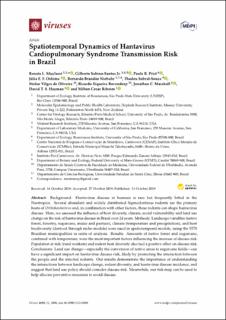| dc.contributor.author | Muylaert, Renata L. | |
| dc.contributor.author | Sabino-Santos Jr., Gilberto | |
| dc.contributor.author | Prist, Paula R. | |
| dc.contributor.author | Oshima, Júlia Emi Faria | |
| dc.contributor.author | Dos Santos, Bernardo Brandão Niebuhr | |
| dc.contributor.author | Sobral-Souza, Thadeu | |
| dc.contributor.author | Oliveira, Stefan Vilges | |
| dc.contributor.author | Bovendorp, Ricardo Siqueira | |
| dc.contributor.author | Marshall, Jonathan C. | |
| dc.contributor.author | Hayman, David T. S. | |
| dc.contributor.author | Ribeiro, Milton Cezar | |
| dc.coverage.spatial | Neotropics | en_US |
| dc.date.accessioned | 2022-12-08T11:29:23Z | |
| dc.date.available | 2022-12-08T11:29:23Z | |
| dc.date.created | 2022-11-22T22:43:01Z | |
| dc.date.issued | 2019 | |
| dc.identifier.issn | 1999-4915 | |
| dc.identifier.uri | https://hdl.handle.net/11250/3036741 | |
| dc.description.abstract | Background: Hantavirus disease in humans is rare but frequently lethal in the Neotropics. Several abundant and widely distributed Sigmodontinae rodents are the primary hosts of Orthohantavirus and, in combination with other factors, these rodents can shape hantavirus disease. Here, we assessed the influence of host diversity, climate, social vulnerability and land use change on the risk of hantavirus disease in Brazil over 24 years. Methods: Landscape variables (native forest, forestry, sugarcane, maize and pasture), climate (temperature and precipitation), and host biodiversity (derived through niche models) were used in spatiotemporal models, using the 5570 Brazilian municipalities as units of analysis. Results: Amounts of native forest and sugarcane, combined with temperature, were the most important factors influencing the increase of disease risk. Population at risk (rural workers) and rodent host diversity also had a positive effect on disease risk. Conclusions: Land use change—especially the conversion of native areas to sugarcane fields—can have a significant impact on hantavirus disease risk, likely by promoting the interaction between the people and the infected rodents. Our results demonstrate the importance of understanding the interactions between landscape change, rodent diversity, and hantavirus disease incidence, and suggest that land use policy should consider disease risk. Meanwhile, our risk map can be used to help allocate preventive measures to avoid disease. | en_US |
| dc.language.iso | eng | en_US |
| dc.rights | Navngivelse 4.0 Internasjonal | * |
| dc.rights.uri | http://creativecommons.org/licenses/by/4.0/deed.no | * |
| dc.subject | land use change | en_US |
| dc.subject | emerging diseases | en_US |
| dc.subject | public health | en_US |
| dc.subject | polygon-based analysis | en_US |
| dc.subject | approximate Bayesian inference | en_US |
| dc.subject | latent Gaussian models | en_US |
| dc.subject | integrated nested Laplace approximations | en_US |
| dc.subject | zero inflation | en_US |
| dc.title | Spatiotemporal Dynamics of Hantavirus Cardiopulmonary Syndrome Transmission Risk in Brazil | en_US |
| dc.title.alternative | Spatiotemporal Dynamics of Hantavirus Cardiopulmonary Syndrome Transmission Risk in Brazil | en_US |
| dc.type | Peer reviewed | en_US |
| dc.type | Journal article | en_US |
| dc.description.version | publishedVersion | en_US |
| dc.rights.holder | © 2019 The Authors | en_US |
| dc.source.volume | 11 | en_US |
| dc.source.journal | Viruses | en_US |
| dc.source.issue | 11 | en_US |
| dc.identifier.doi | 10.3390/v11111008 | |
| dc.identifier.cristin | 2078769 | |
| dc.source.articlenumber | 1008 | en_US |
| cristin.ispublished | true | |
| cristin.fulltext | original | |
| cristin.qualitycode | 1 | |

